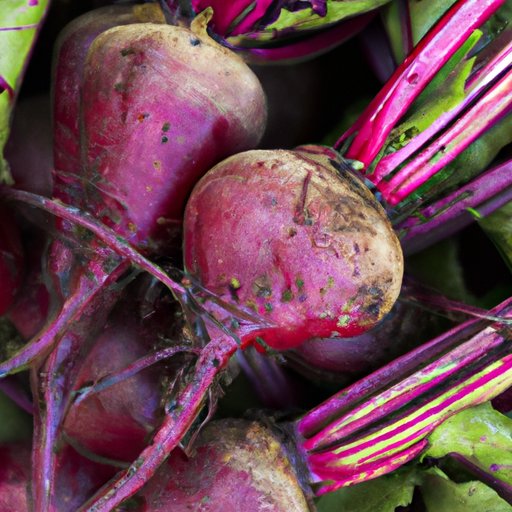
Introduction
Cooking fresh beets can be quite daunting, especially for those who have never prepared them before. However, with the right techniques, fresh beets can be a tasty and nutritious addition to any meal. This article will provide a comprehensive guide to cooking with fresh beets, covering everything from beginner’s cooking methods to innovative techniques and nutritional value.
Beginner’s Guide to Cooking Fresh Beets: A Step-by-Step Tutorial for First Timers
There are three primary ways to cook fresh beets: boiling, roasting, and steaming. When boiling fresh beets, rinse them thoroughly and trim the stems and roots, leaving about one inch attached. Place the beets in a large pot, cover with water, and bring to a boil. Reduce heat and simmer until tender, about 30-45 minutes. Once cooked, drain, peel, and slice or dice as desired. Season with salt, pepper, and olive oil or butter.
When roasting fresh beets, preheat the oven to 375°F. Rinse and trim the beets, leaving one inch of the stems and roots attached. Place them in a baking dish, drizzle with olive oil, and season with salt and pepper. Roast until tender, about 45-60 minutes. Once cooked, let the beets cool before peeling and slicing or dicing. This method produces a slightly sweeter taste than boiling.
When steaming fresh beets, peel and slice the beets into desired sizes and steam for around 15-20 minutes. Add salt, pepper, and olive oil or butter to enhance flavor. Serving steamed beets is easier and faster than boiling or roasting them.
How to Cook Fresh Beets Without Losing Their Nutritional Value: Tips and Tricks for a Healthy & Delicious Meal
Fresh beets are a great source of fiber, vitamins, and minerals, including vitamin C, potassium, and folate. Unfortunately, some cooking methods can reduce their nutritional value, so it’s essential to know how to retain as much of it as possible.
To preserve the nutrients, it’s best to cook fresh beets with their skin on and avoid peeling until after they are cooked. Proteins and fiber are stored just under the skin. Boiling beets cause some nutrients to diffuse into the water. Therefore, alternate methods such as roasting and steaming will help keep most of the nutrients intact. To retain the nutritional benefit, avoid adding refined sugars or unnecessary ingredients.
Quick & Easy Recipes Using Fresh Beets: From Salads to Soups and Beyond
Beets are versatile and can be used in various ways. Below are some easy recipes using beets:
- Beet Salad: Roast beets and chop them up with greens, cheese, nuts, and a vinaigrette dressing.
- Beet Hummus: Cook them, mix with garlic, tahini, and chickpeas for a flavorful dip.
- Beet Soup: Boil beets, dice them so that they cook faster, add stock, and blend to make a soup.
Beets pair well with salads, sandwiches, and smoothies. The key is to acknowledge their earthy and sweet flavors when selecting ingredients.
Innovative Ways to Cook Fresh Beets: Discover Some Unconventional Methods and Get Creative in the Kitchen
Pickling, juicing, or grilling are unique ways to use fresh beets that can take up your menu plan.
Pickling combines vinegar and sugar with fresh beets. You can use your preferred spices such as coriander or peppercorns. This method preserves the beets and gives them a tangy taste that complements salads and sandwiches.
Juicing requires a juicer and fresh beets without cooking, once juiced, it’s possible to add them to other beverages or drink alone.
Grilling is another way to prepare fresh beets, roasting them on a fire pit or charcoal instead of the oven. The flavor is more prominent, and it may pair better with some ingredients.
From Farm to Table: The Ultimate Guide to Cooking Fresh Beets Straight from the Garden
There are numerous benefits of buying fresh beets from your garden or local farmers market, such as buying directly from the source, reducing waste and preserving nutrients. They also have longer-lasting freshness compared to store-bought beets that may have an extended shelf life. You can store beets in the fridge with its skin on, placed in a sealed container to avoid spoilage.
Stems and leaves are also edible and should be used instead of throwing them away. Leaves pair well with salads, and stems are ideal for soups and stews.
Conclusion
Beets are an excellent addition to any recipe and incredibly nutritious, making them a worthwhile purchase. Whether beginner or experienced cook, this guide has provided valuable insights in ensuring that you cook perfect beets each time.





